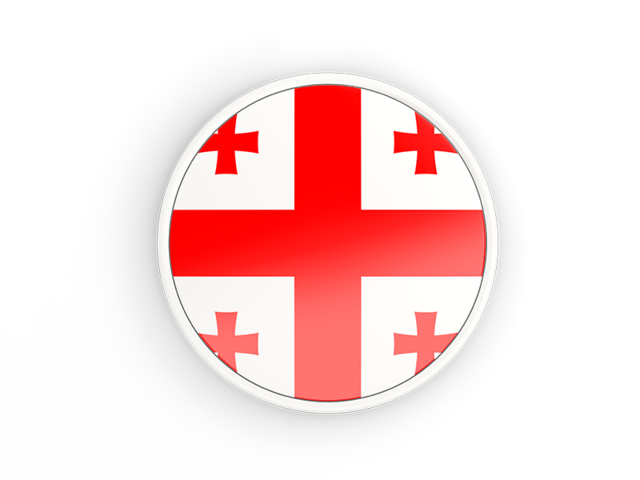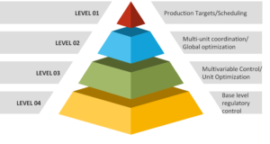
Gadi Briskman
Product Manager at Modcon Systems Ltd
As a newcomer to the processing industry, coming from the background of robotics and Machine Vision, I’ve tried to interpret the existing approaches to representing the hierarchy of process control in the context of the current project, where Modcon AI solution is deployed at an oil refinery.
A discussion about the hierarchy of process control seems to be timely in one particular context: the promise AI holds for Advanced Process Control industry. While the promise may be well founded, a meaningful discussion about the added value AI and Machine Learning in general can provide in this already established and quite conservative industry requires breaking down the general notion of process optimization into more manageable chunks. The end-to-end process optimization is a valid goal, however achieving it in a single iteration wasn’t practical in the past, and the advent of new optimization capabilities, relying on AI/Machine Learning is not likely to change that.
The idea of Advanced Process Control (APC), spanning all areas of production in a technological process in refinery, chemical, food and pharmaceutical industries has existed at least since late 1970s. The computation tools, implementing this approach have evolved over time. Starting from linear approximation of process dynamics, optimization the non-linear process models was further explored. Neither give an exhaustive answer to all real-life situations. Highly non-linear processes can’t be well approximated by linear models, while precise non-linear models lead to computationally heavy calculations that can’t be executed in real time. This is the gap, the current Data-driven methods of optimization address.
The hierarchy of Advanced Process Control (APC) was researched in the past. With modest adaptations, the layers of the hierarchy offered in the cited publications can well be used to frame the discussion about planning and implementing a process optimization solution, some or all of its components being based on AI/Machine Learning algorithms. The value of working on the basis of such a hierarchy exists, in my view both from the solution provider and the customer’s side. Its understanding may help to set proper expectations, implement the solution components in a meaningful order and, generally, improve the success chances of a process optimization project.
One suggested hierarchy was offered by Juergen Hahn and Thomas F. Edgar in Kirk-Othmer Encyclopedia of Chemical Technology, 2014 (Figure 1). The hierarchy, suggested by Hahn and Othmer, reasonably has Planning and Scheduling at the top layer, while the regulatory control appears at the level 3a. Regulatory control is a term, corresponding to basic controllers, keeping one process parameter at a predetermined value.
A number of observations are worth mentioning regarding this breakdown. Firstly, layers below 3a are not relevant for the control optimization process, as there is no control law applied in them. Secondly, the separation between layer 4 and layer 3b may be applicable to some technological processes, but seems not very practical in general. Layer 4 doesn’t reflect the breakdown of the production between multiple units that may work in parallel, while dictating at the same time process setpoints for the layer 3b, which can and should, in many situations be handled in the latter.
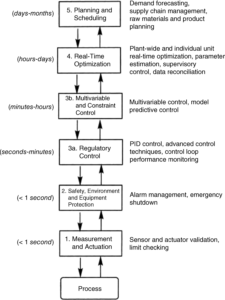
Figure 1
A similar breakdown is offered in an article by Vaccari and Pannocchia, 2016 (Figure 2). Here, again, the separation between the “Real Time Optimization” and “Advanced Control Systems: MPC” seems artificial, while the distribution of production among possible chains of units isn’t explicitly incorporated into the model.
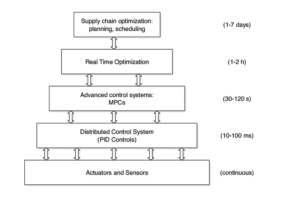
Figure 2
A third example of process control hierarchy appears in an article by Perry Nordh, 2016 (Figure 3). In this chart, a single layer covers the gap between the Production Control at the top and the regulatory control. This may be a too high-level breakdown to support the planning of an optimization process.
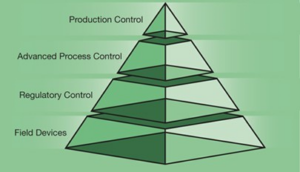
Figure 3
Our work at Modcon best fits the simple 4-layer model presented in Figure 4. This approach differentiates between optimization at the level of an individual unit that happens at Layer 3 and coordination of tasks across multiple chains of units, taking place at Level 3. The described structure reflects Modcon’s bottom-up approach to a control optimization project. In our view, firstly, the optimization at the unit level has to take place. It should likely start as a recommender system, and then slowly move into executing control, as the customer gains confidence in the system’s advice. Only as a next step, automation of coordination between multiple plant units should take place, with eventual incorporation of the top layer: setting production targets and scheduling.
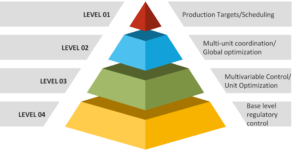
Figure 4
I would appreciate comments, suggestions and observations you may have after reading this summary.
Sources:
- Hahn, Juergen & Edgar, Thomas. (2014). Process Control. 10.1002/0471238961.1618150307091522.a01.pub3.
- Vaccari M, Pannocchia G. A Modifier-Adaptation Strategy towards Offset-Free Economic MPC. Processes. 2017; 5(1):2. https://doi.org/10.3390/pr5010002
- Perry Nordgh, P.Eng. Understanding Advanced Process Control (2016), available from: https://www.aiche.org/resources/publications/cep/2016/june/understand-advanced-process-control



